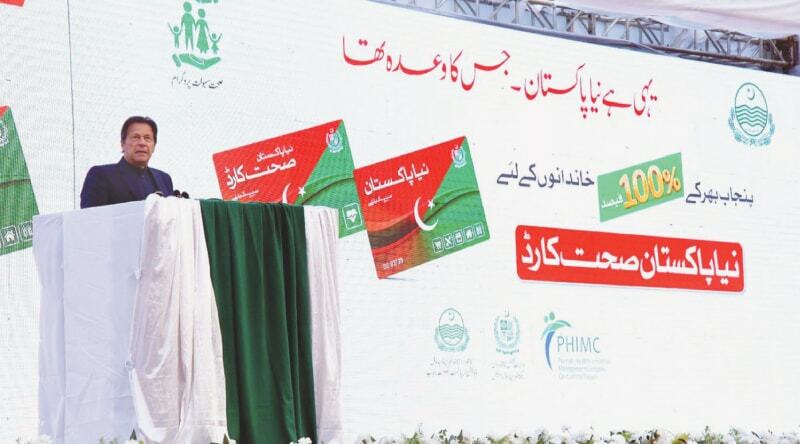In 2016, Pakistan Tehreek-e-Insaaf (PTI)’s government launched the ‘Sehat Sahulat Programme’ (SSP) (translation: Health Benefit Programme), the first of its kind health insurance scheme in the province of Khyber Pakhtunkhwa and later in January 2022 as ‘Qaumi Sehat Card’ (translation: National Health Card) scheme across Pakistan. This national health insurance scheme is a first in a series of welfare programme initiatives undertaken by PTI’s government. SSP aims to fulfil the United Nations’ Sustainable Development Goal 3.8 which focuses on achieving “universal health coverage, including financial risk protection, access to quality essential health-care services and access to safe, effective, quality and affordable essential medicines and vaccines for all”. Though a monumental step towards universal healthcare by ensuring access to high quality health services for the under privileged population without any financial restraints, it has its drawbacks and only addresses a few underlying issues with the overall health system of Pakistan.
Affordability and Accessibility to Healthcare Services in Pakistan
According to statistics, in 2018, “for 963 persons there is one doctor, for 9,413 persons there is one dentist, and one hospital bed per 1,608 persons in Pakistan”.
Government of Pakistan’s 2018 Economic Survey.
SSP is a pertinent step towards bettering a healthcare system which faces troubles on multiple fronts. Almost half of Pakistan’s population does not have access to primary healthcare facilities due to either absence of proper infrastructure and facilities or limited number of doctors amidst an increasing population. A 2018 economic survey issued by the Government reported that one doctor is available for 963 persons, one dentist per 9,413 persons, and one hospital bed per 1,608 persons in Pakistan. Furthermore, a report issued by the Pakistan Bureau of Statistics in 2019 concluded that for an approximate population of 220 million, there are only about 14,000 medical facilities and an approximate of 132,000 beds in both rural and urban areas. This includes, hospitals, dispensaries, Rural Health Centres (RHC), and Maternal Health Centres (MHC).
The rural areas of Pakistan are disproportionately impacted with almost non-existent healthcare services, forcing people to travel miles to reach city centres to get access to better healthcare. While the government has made attempts by establishing Basic Health Units (BHU) and Rural Health Centres (RHC) in districts and villages that particularly lack access to healthcare services, it is not sufficient to cater to the growing population. Most significantly, specialised healthcare services like those for treatment of cancer, liver or kidney transplant, or neurology are only available in a handful of hospitals situated in big cities such as Lahore, Islamabad, Karachi, and Peshawar.
The situation is alarming because majority of the population resides in the low to middle income bracket with about 40 percent of the population living below poverty line and one-third earning less than $3.2 a day. This combined with the face that about 42% of the population does not have health insurance, means that majority of the population is simply unable to afford the limited healthcare services that are available.

How does the Sehat Card work?
The Sehat Card is designed keeping in mind the present challenges faced by the people of Pakistan in accessing better healthcare services. The card covers a range of procedures including secondary and tertiary medical treatment ranging from routine in-patient surgeries, maternal care, fractures and injuries to major surgeries such as organ transplant, cancer treatment, heart complications, diabetes, kidney dialysis and chronic infections. The card covers all inpatient procedures and surgeries for any disease for majority of the qualifying population, i.e., families who otherwise would not have been able to afford such healthcare services. Under this scheme, “a family can use up to 400,000 PKR for priority health care services and 60,000 PKR for secondary health care services” in a year. However, in case of life threatening circumstances, need for maternal healthcare facilities, and for patients requiring cardiological interventions, cancer treatment, dialysis and renal transplant, the limit can be refreshed after the said limit for the year is exhausted.
The Sehat Sahulat Programme relies on two primary avenues for fund generation. First, the ’fund retention’ scheme was used to generate revenue for the Sehat Sahulat Programme in Khyber Pakhtunkhwa and is now extended to other provinces. Under this scheme, the provincial public hospitals are to retain a certain percentage of their income; two-thirds of which will further be retained to be spent on improving hospital services, equipment, and to pay doctors’ fees, whereas one-third of it will be transferred to the provincial government to then be used for this health insurance scheme. Second, the government is partnering with the private sector and private insurance companies to generate funds to provide health services to the masses, particularly in the least developed districts of the country.

Sehat Sahulat Programme: Success or Failure?
While political impediments have slowed adoption of the scheme in provinces of Baluchistan and Sindh, Sehat Card was readily adopted across Punjab under PTI’s government. According to the recently released statistics by the Department of Specialised Health and Medical Education, about PKR 47 billion have been provided to ensure treatment under the Sehat Card, and about 803 government and private hospitals across Punjab have been instructed to provide free healthcare services which are covered under the scheme. Under the scheme, maternal care, eye treatment, hernia, heart surgeries, cancer treatment has been provided to scores of people for free. Furthermore, the ambit of the treatment has also been recently expanded to include free access to robotic radiotherapy for cancer patients.
While the statistics imply resounding success of a much-welcomed initiative, concerns have been raised over the long-term sustainability of the scheme across the country. While the initial reports from Punjab gave the impression that the SSP might provide a much-needed respite in accessing healthcare facilities for families from financially constrained backgrounds, loopholes started to emerge. Since the beginning of implementation of SSP in January 2022, the government has been able to cater merely 93,000 families out of the 5 million eligible in 36 districts of Punjab so far despite their commitment to extend the service to almost 32 million people in Punjab, or roughly about 30% of the population of the province. Administrative lags, bureaucratic hindrances, incomplete information of families in the system, ineffective liaison with private hospitals, lags on part of insurance companies and inability to procure funds to make timely payments on part of the government all have adversely impacted the implementation of the health insurance programme.
For example, as part of the public-private partnership, insurance companies such as State Life Insurance have been supporting the SSP in both public and private hospitals, for which they are reimbursed by the government in four equal instalments of PKR 2.5 billion. However, failure of government to ensure payments in the given timeline has impacted the entire process. Resultantly, the hospitals now have to either delay or deny treatment to patients. Furthermore, most hospitals pressure patients to pay extra costs for laboratory tests and medicines, with details of same not provided to the patients, without which keeping record of cost break up is difficult. Raising suspicion on transparency of the programme, the insurance companies are issuing reimbursements without recording the cost-break up for the procedures carried out. This means that there is an inadequate record keeping of how much is spent on the procedures, and how much is pocketed by the hospitals in the name of consultant fee and hospital shares. This lack of transparency and misallocation of funds has resulted in the Punjab Health Insurance Initiative Management Company demanding further PKR 5 billion for the programme, beyond the current allocation of PKR 12 billion by the government for the current fiscal year. Other concerns such as the necessity to carry out such procedures by private hospitals, inflating costs for surgeries by hospitals, issues on standard operating procedures, quality of equipment and training of medical staff especially in public hospitals creates further hindrances in providing quality healthcare for all.
Moving Forward
While the SSP has proven beneficial for scores of families across Pakistan and is indeed a necessary step towards bettering the health care system of Pakistan, it could still benefit by addressing existing loopholes along with considering options for expanding coverage. For example, currently, outpatient procedures, medicines for long term illnesses such as hypertension, mental health and dental health is not covered by the programme. This effectively leaves a large segment of the population financial incapable of accessing these services.
Furthermore, the difference in the quality of healthcare provided in the public and private sector is ever increasing and is a cause for concern given how limited health care facilities are operating to provide quality healthcare to an increasing population. Therefore, firstly, the government needs to take steps to ensure that the health services provided by the public sector are at par with the private sector. Secondly, it needs to allocate funding to establish more healthcare facilities, particularly in rural areas to enhance accessibility. Lastly, it needs to build a more sustainable mechanism to generate revenue for long term operability of the programme. To achieve this, administrative and bureaucratic implementation system must be revamped to increase transparency, accountability and surveillance to monitor how insurance companies and hospitals are managing funds under the SSP.
The opinions expressed in this publication are those of the author. They do not purport to reflect the opinions or views of IVolunteer International.
IVolunteer International is a 501(c)3 tech-nonprofit registered in the United States with operations worldwide. Using a location-based mobile application, we mobilize volunteers to take action in their local communities. Our vision is creating 7-billion volunteers. We are an internationally recognized nonprofit organization and is also a Civil Society Associated with the United Nations Department of Global Communications. Visit our profiles on Guidestar, Greatnonprofits, and FastForward.


